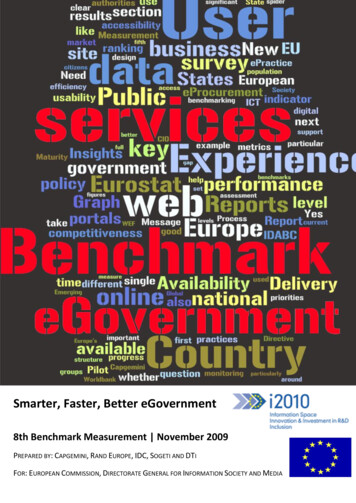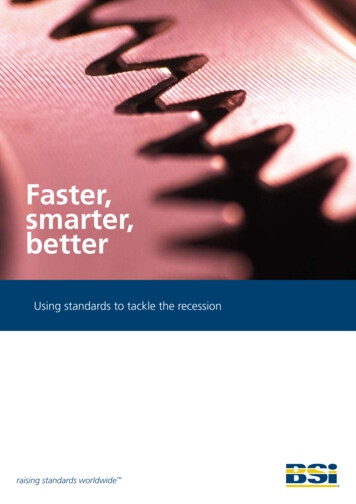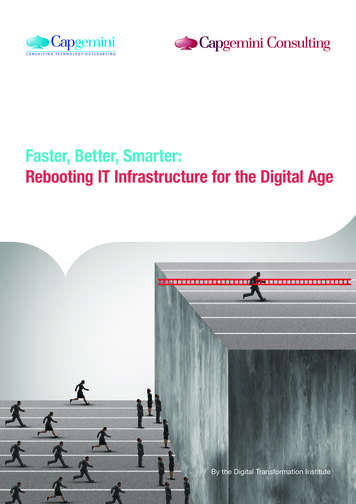
Transcription
-Smarter, Faster, Better eGovernment8th Benchmark Measurement November 2009PREPARED BY: CAPGEMINI, RAND EUROPE, IDC, SOGETI AND DTIFOR: EUROPEAN COMMISSION, DIRECTORATE GENERAL FOR INFORMATION SOCIETY AND MEDIA
European Commission Directorate General for Information Society and MediaSmarter, Faster, Better eGovernment8th eGovernment Benchmark Measurement November 2009The opinions expressed in this study are those of the authors and do not necessarilyreflect the views of the European CommissionFor more information about this survey, please contact:European CommissionDirectorate General Information Society and MediaUnit C.4 Economic and Statistical AnalysisE-mail: infso-i2010@ec.europa.euProject Team LeadershipGraham Colclough – Vice President Global Public Sector CapgeminiGraham.Colclough@capgemini.comDinand Tinholt – Programme Manager eGovernment Benchmark CapgeminiDinand.Tinholt@capgemini.comExecuted by Barbara Lorincz, Graham Colclough, Dinand Tinholt, Constantijn van Oranje, Gabriella Cattaneo andLaurent Jacquet.With contributions from: Wendy Carrara, Gwendolyn Carpenter, Helen Schindler, Rosanna Lifonti, Dominic Huggins andJeremy Millard.
Table of contents1.Introduction1.1The 2009 report: context setting1.2The 2009 report : purpose and structure2. The eGovernment Benchmark Method2.1The benchmark metrics2.2Transforming rankings into insights3. Results for the 20 basic services3.1Sophistication of Services3.2Ranking full online availability3.3Growth and governance4. eProcurement Results4.1Policy Background4.2eProcurement Availability Benchmark4.3eProcurement Development Models4.4eProcurement Process Benchmark4.5eProcurement Post-Award Process Benchmark5. Adding the user perspective5.1What has been measured5.2Key findings for Europe5.3Best practices across Europe5.4Trends in User Experience5.5User satisfaction monitoring5.6Learning from world leaders to develop the piloted method6. Context7. Development of the Measurement Approach8. Insights from the Country Reports8.1“Top Priorities” for Participating Countries8.2Approach to Governance and Implementation8.3Europe viewed on a worldwide stage9. Better for Customers9.1Use of Online Services9.2Increasing Take-Up9.3A paradigm shift towards customer-centric services10. Better for Businesses10.1 Doing business with Government: state of play10.2 The Single Market & the impending Services Directive11. Better for the Public Purse11.1 From an Economic to a Fiscal and Budgetary Crisis11.2 eProcurement as a vehicle for efficiencies and cost savings11.3 Achieving Internal Administrative Efficiencies11.4 Reaching beyond the ‘Tipping 4650545556565758595961616363646666666868
12. Country Reports12.1 Summary text12.2 Key facts12.3 Societal Figures12.4 EU activity12.5 Key organisational facts12.6 Close-up: results in the EC eGovernment benchmark 200912.7 Top 5 strategic eGovernment priorities for 2009:12.8 Biggest eGovernment success stories in the last 2 years?12.9 Best practices and URLs:13. Detailed results for the 20 services13.1 Income taxes13.2 Job search13.3 Social security benefits13.4 Personal document13.5 Car registration13.6 Building permission13.7 Declaration to police13.8 Public libraries13.9 Certificates13.10 Enrolment in higher education13.11 Announcement of moving13.12 Health-related services13.13 Social contributions13.14 Corporate tax13.15 VAT13.16 Company registration13.17 Statistical data13.18 Customs declaration13.19 Environment-related permits13.20 Public procurement14. The 20 services- method14.1 The data collection and management process14.2 Scoring rules for the Full Online Availability indicator14.3 Non-relevant (sub-)services15. The eProcurement- method16. The User Experience- method16.1 Usability16.2 Accessibility16.3 User Satisfaction Monitoring16.4 One stop shop approach - Availability of 20 online services16.5 User focus portal design16.6 Accessibility web 160160164164167171171171172172172172175
Table of figuresFigure 1: Full online availability trend from 2001 to 2009 for EU27 . 3Figure 2: Sophistication of service clusters in the EU27 . 4Figure 3: Sophistication and growth in the EU27 . 4Figure 4: Full online availability 2007-2009 . 5Figure 5: Sophistication 2007-2009 . 5Figure 6: Sophistication 2007-2009 . 6Figure 7: User experience in the EU27 . 7Figure 8: Online sophistication by country size and governance type . 10Figure 9: eGovernment take-up gap . 11Figure 10: Status of Business Services Maturity . 12Figure 11: Beyond the ‘Tipping Point’ . 14Figure 12: The 2009 report structure . 17Figure 13: The benchmark’s five-stage maturity model 20Figure 14: The eProcurement Value Chain . 22Figure 15: Sophistication 2007-2009 . 20Figure 16: Sophistication 2007-2009 for EU27 . 25Figure 17: Sophistication of service clusters in the EU27 . 25Figure 18: Pro-active 5th sophistication level 2007-2009 . 26Figure 19: Full online availability 2007-2009 . 27Figure 20: Full online availability trend from 2001 to 2009 for EU27 . 27Figure 21: Full online availability trend from 2001 to 2009 – EU15, Non-EU15 and EU27 . 28Figure 22: Sophistication and growth in the EU27 . 29Figure 23: The eProcurement Availability Benchmark of Contracting authorities . 33Figure 24: The eProcurement availability benchmark by government tier . 34Figure 25: The top 10 in the eProcurement Availability Benchmark . 34Figure 26: The eProcurement Availability Benchmark by Development Model Clusters . 35Figure 27: The eProcurement Pre-Award Process Benchmark . 36Figure 28: The top 10 in the eProcurement Pre-award Benchmark . 37Figure 29: The eProcurement Pre-Award Process Benchmark by Subphase . 37Figure 30: User experience in the EU27 . 41Figure 31: Online sophistication versus usability of the 20 eGovernment services. 421
Figure 32: Framework for User Satisfaction Monitoring . . 47Figure 33: Societal challenges requiring ICT innovations in the next decade . 55Figure 34: The eGovernnment take-up gap for citizens . . 59Figure 35: The eGovernnment take-up gap for businesses . 60Figure 36: Sophistication of services by delivery level . 63Figure 37: Sophistication of services by delivery level . 64Figure 38: Beyond the Tipping Point 69Figure 39: Income taxes . 140Figure 40: Job search services . . 141Figure 41: Social securities benefits . 142Figure 42: Personal documents . .143Figure 43: Car registration 144Figure 44: Application for a building permission . 145Figure 45: Declaration to the police . 146Figure 46: Public Libraries (catalogues, search) . 147Figure 47: (Birth and marriage) Certificates 148Figure 48: Enrolment in higer education 149Figure 49: Announcement of moving . 150Figure 50: Health-related services . 151Figure 51: Social contribution to employees 152Figure 52: Corporate tax 153Figure 53: VAT .154Figure 54: Registration of a new company 155Figure 55: Submission of data to statistical offices . 156Figure 56: Customs declaration 157Figure 57: Environment related permits . 158Figure 58: Public Procurement . 1592
Abbreviations and termsWe recognise with a multiplicity of different readers, there will be many unfamiliar terms and abbreviations. There arealso many common terms that are understood in different ways (e.g. ‘cloud computing’). We have captured someterms below particularly for the benefit of the reader of the Extended Executive Summary. Most other terms aredefined throughout and/or in the Appendices. This is not an exhaustive list.Country tzerlandCyprusCzech bourgLatviaMaltaThe iaSlovakiaUnited KingdomTermExplanationEU27 This term refers to the participating countries, whichincludes all EU Member States (MS) and Croatia, Iceland,Norway, and Switzerland.20 Basic ServicesThe 12 citizen and 8 business services that have beenmeasured since 2001.5-stage maturity ModelGovernments’ services are described according to thefollowing stages, as used in previous reports: (i)information, (ii) one-way interaction, (iii) tion/automation.SophisticationA core benchmark indicator used to assess the 20 basicservices against the 5-stage maturity model.Full Online AvailabilityA core benchmark indicator used to assess the 20 basicservices against the fourth and fifth stages of the 5-stagematurity rassessingwhethereProcurement is visible and available to potential suppliersonline.eProcurementBenchmarkProcessNew benchmark indicator measuring the availability of themain process phases of eProcurement, divided into thepre-award and the post-award phases.User ExperienceThis term is measured using 5 criteria described in Part B.Other terms that are commonly used and related include:customer centricity; customer friendly personalisation;user-focused.Cloud ComputingThe consolidation and virtualisation of computing assetsand data, including the use (by customers / partners) ofweb/internet-based services (thus both back and frontoffice related).3
Extended Executive SummaryExtended Executive SummaryKey Points1.EU27 advancement: Full OnLine Availability 71% (59%: ‘07); Sophistication 83% (76%: ’07).2.eProcurement (new) Availability: 56% EU27 ave.; well behind 2010 target of 100%. Key for singleopen market. Several good practice examples of nationally controlled public expenditure.3.Some countries show leapfrog results; some continued high performance. Reasons offered.4.Increased focus on ICT as a means to address fiscal and budget constraints5.User Experience (pilot) measures show EU27 averages from 34% to 81% for the five measures,with some notable examples of leading practices.6.Personalised services gaining ground and becoming more commonplace across Europe.7.User empowering technologies push Governments to redesign their eGovernment services.8.Upgrade of measurement system is needed and planned – in collaboration with countries.I. THE POLICY CONTEXTThis 2009 report opens a new chapter in EU eGovernment benchmarking. We are now two years on from the lastthmeasurement in September 2007. The report captures the results of the 8 measurement of eServices across Europe.It establishes the foundations for the progressive and planned modernisation of pan-EU eGovernment comparison.This benchmark has proven to be a policy-informing tool at both a European and Member State level since itsinception in 2001. As we approach the end of the Lisbon i2010 policy timeframe, we now need new eGovernmentpolicies to suit the next planning horizon. Technology is changing our lives in many ways, and changing the way thatpublic services are governed and delivered. We therefore need new eGovernment Action plans.We are confronted by a new paradigm. One where the heightened expectations of customers must be delivered withconstrained public resources. The short term economic crisis has resulted in a long-term fiscal and public budget crisis.This will lead to a decade of austerity. Yet there is much more than just economic and budget considerations that willcause grass root changes. New policies will be required that address global challenges in areas such as public security,climate change, and energy. New policies will be required for the very local challenges of societal cohesion: the resultof continuing demographic changes, mobility, and urbanisation. And new policies will also be required that addressnational challenges like escalating healthcare costs, through aging society and life-style change; exacerbated by theimbalance between working and non-working populations. These represent a growing and substantial financial burdenon society. This calls for transformational change. The key question is: “what role can eGovernment play in support ofthis?”Society will not stand and watch as politicians govern. Public Administrations serve citizens holding greater opinionand greater sway in what can and will happen. Society will expect more and they will hold Government to accountmore. This is already tangible.What is needed is a more mature and deeper relationship between the public and the private sector; sustainedpolitical will and strategic leadership; greater collaboration at all levels of government (including international); anddifferent service delivery models. This will cause blurring of the boundaries between customer and administration, andbetween public, private, and third sectors. We can only address these new challenges by ensuring that we activelyengage with stakeholders.What role then does technology play in policy setting? What we know is that we live in an era of highly dynamicevolution of technology. With many new tools and many new possibilities. Society has realised this and is gaining from1it; Administrations must do so too. It was observed that “every policy initiative becomes sooner or later an ICTproject”. It is in this policy context that this eGovernment benchmarking report sits.1Wolfgang Schäuble, German Minister of Interior, Statement at eGovernment Conference April 2007, Berlin1
Extended Executive SummaryII. TECHNOLOGY AS A TOOL FOR TRANSFORMATIONth2ICT is no longer the servant to business operations; it has become an integral partner. New devices (the 4 screen )have become commonplace. Social networking is very much on the rise. We are offered access through multiple(technology) channels that offer substantially lower costs and in many instances better service levels. Such changeoffers profoundly greater opportunities for active engagement and participation. Technologies enable visibility,structuring and transfer of information that can deliver more seamless services, from need to fulfilment. Businessintelligence systems offer the potential to deliver customer insights to support choice and tailoring of services. It willalso enable performance to be managed in far better ways.Technology is no longer the inhibitor. It is the mindset and resource of Administration, and of the customer that willmake the difference.Recent steps are evident to change the model of government: to make Administration more open and transparent.Are these early signs of a fundamental change in user-centric service delivery and true participative democracy?There are challenges however in these developments. Building and retaining citizen confidence in the ability ofAdministration to appropriately manage personal information is a prerequisite. Providing choice in how personalinformation is managed will be important. Data security has thus become a priority concern. Whilst significant stepshave been taken to advance the use of technology in public service delivery, there remains a significant gap betweenthose digitally enabled and those not – through choice or circumstance. Closing this gap is crucial to the economicperformance of Europe. And it is important to the social cohesion of Europe too. The vital ingredient that all publicagencies must focus on is the development of trust. This underpins many if not all of the ambitions to transform publicservices through technology.The sector has invested heavily in technology over the last decade. It is time to reap returns from these investments.Leaders and decision makers seek proof that these investments were wise. They need confidence in the ability of thetechnology to make evidence-based gains. It is time for the digital assets that have been created to be used and to addvalue. It is time for delivery.III. HOW WE MEASURE EUROPE’S PROGRESSThis eGovernment benchmark is well established. We now start the process of modernisation. In doing so we willaddress: “what is considered ‘progress’ in eGovernment? And how do we measure progress towards this?”Fundamental to the measurement process is the active participation of the Member States. The design, methodenhancement, data collection and validation, are done in collaboration with Member State representatives.This year we have 31 participating countries including all EU Member States, Croatia, Iceland, Norway, and SwitzerlandWe envisage further expansion in upcoming years. This becomes more important as the need increases to shift frominternal EU comparison, to compare Europe’s progress to leading countries and regions across the world.We have measured the “20 basic public services” since inception. These remain. They assess the availability of theseservices, and the sophistication of them as offered through 14,000 public service provider websites across Europe. Forsome countries these measures have become less relevant as they reach high levels of maturity. For others they arestill of great relevance. What it does provide is a consistent progress measurement over time; something that weshould not lose.This year already sees some enhancements to the measurement system.We have put focus on high impact service areas. eProcurement is one such area that is included in the survey. It isalso a high-impact area that is receiving focus as one of the CIP (competitiveness and innovation programme) largescale pilots. Public Procurement represents approximately 16% of the European Union’s GDP. Providing visibility ofpublic tenders to the multiple suppliers across Europe is vital to the goal of a vibrant economy and an open singleEuropean market. Targets were set in 2005 for advancing eProcurement. We must measure how we are progressing inachieving these. The availability of eProcurement has been measured for 746 authorities across all tiers ofGovernment. The single data point that measured eProcurement in past years, principally only on national platforms,2“The 4th Screen” (1st Movie Screen; 2nd TV; 3rd PC; 4th Mobile)2
Extended Executive Summary3now evaluates 19 process data points that consider the pre-award sourcing, and post-award transaction phases . Thesehave been applied to 134 public eProcurement platforms. eProcurement is thus in its first year of measurement inmuch greater depth.User Experience is now recognised as being an essential gauge to the take-up of online services. This is a morecomplex area to measure as it is affected by culture and norms. It also requires more in-depth measurement, beyondthe front-of-office website. We have piloted a User Experience measurement, and envisage that this will developconsiderably going forward.A continuous process of enhancement to the benchmarking method is now underway, to create a dynamicmeasurement instrument that will retain the existing comparability over time, and the principle of open collaborationwith participating countries. This will enable new (policy) areas to be investigated. As these may be more or lessrelevant to participating countries, a system is foreseen with elective measurement building blocks. Such developmentsmay consider: citizen and business ‘life-events’ (in many instances an aggregation and enhancement of some of the 20basic services); channel migration; the development of ‘cloud services’; openness and transparency; back-officedevelopment; regional progress; and domain specific measurement. We also intend to make full use of other availableand relevant measurements to enrich the findings and insights that can be drawn from the process.IV. BENCHMARK RESULTSThe “20 BASIC SERVICES”Europe shows continued steady progress interms of full online availability. The overallEU27 measure has risen to 71% in 2009 from59% in 2007. This can be seen in theaccompanying figure. The difference acrosscountries is still significant, with a range of68% but with a marked reduction with respectto 2007 (85% range).The most advanced countries show saturationagainst both of these measures for many ofthe 20 services. This underpins the need torefresh the measurement system.10080Businessesin %In terms of sophistication, Europe stands at83%, compared with 76% in 2007. Thisassesses the degree of interaction betweenservice provider and user, from simpleinformation provision to personalised proactive case handling. Europe is presentlythclassified at the top of the “transactional” 4(of 5) eGovernment levels. On this measurethere is less difference between countries: arange of 44%.Full online availabilityTrend from 2001 to 2009 for EU27 60All re 1: Full online availability trend from 2001 to 2009 for EU27 As in the past, there remains significant variance (20% fully online; 12% sophistication) between the results of servicesfor businesses (of which there are 8) and services for citizens (of which there are 12). This reflects the inherent natureof business services, being more homogeneous in form. Services for citizens, by comparison, are highly diverse inrange, and citizens have far more heterogeneous needs and behaviours.3As is explained in the eProcurement chapter, only the pre-award data will be presented in this report.3
Extended Executive SummaryFor all 20 services, four clustershave been assessed: incomegenerating (for );servicereturns (e.g. health, social,libraries); and permits andlicences (e.g. building, education,passport). The progress for eachof these since 2007 is shown inthe accompanying figure. Thisshows the greater maturity ofincome-generatingservices.Their form (homogeneous, highvolume, income generating)make them more attractive totechnology-enable first.Sophistication of service clusters in the EU27 FeaturesTaxes, social contributions,VAT, customs.Mainly delivered atnational level.Top scores for allcountries.2009Income generating1002007755025Permits and licencesRegistration0FeaturesFeaturesBuilding, passport,education, environmentCar, company, birth & marriage, moving,statistical dataOften delivered atregional and local levels.Least sophisticatedcluster but shows goodprogress.Covers one-off life events.Average performance and growth.ReturnsFeaturesHealth, libraries, procurement, policing, jobsearch, benefitsGreater progress is howeverobserved for the other clusters,notably permits and licences.Comprises frequently used services.Average performance and growth.Figure 2: Sophistication of service clusters in the EU27 We also observe a small number of countries making very significant improvements – essentially ‘leapfrogging’ theirpeers. This is shown in the figure below.Sophistication and growth in the EU27 Fast growersHIGH8 countriesModerate adopters8 countriesSaturated top12 countries2 countriesLOWSophistication 2009LeapfroggersLatviaPoland15 to gSwedenSlovakia10 to 15%5 to 10%Growth over the period 2007-2009Figure 3: Sophistication and growth in the EU27 40 to 5%
Extended Executive SummaryThe leading six nations on the full online availability of the basic 20 services are: Austria, Malta, Portugal, the UnitedKingdom, Sweden and Slovenia with the top 4 having the same score.Full online availability 2007-2009100908071%70in %6059%504030Full online availability in 200920Full online availability in 2007EU27 average 200710EU27 average 20090AT MT PT UK SE SI EE FI DK IE FR NO ES NL DE BE IT LU LV HU CZ LT IS SK PL CY EL RO BG HR CHCountriesFigure 4: Full online availability 2007-2009With regard to the online sophistication of the 20 basic services, the leading six nations are Malta, Portugal, Sweden,Austria, Slovenia and Estonia.Sophistication 2007-20091009083%8076%70in %6050403020Sophistication in 2009Sophistication in 200710EU27 average 2007EU27 average 20090MT PT SE AT SI EE FI UK IE DK FR BE DE ES NL NO LU IT LV CZ LT IS HU PL SK CY EL CH BG RO HRCountriesFigure 5: Sophistication 2007-20095
Extended Executive SummaryePROCUREMENT MEASURE (New)With 12 million companies, of which 99% are SMEs, and the value of public procurement advertised at EU level4amounting to around 1500 billion , Europe has substantial opportunity to benefit from a single market approach.There are no or few single market measurement targets, in itself an opportunity.eProcurement targets were set in 2005 to achieve 100% online availability, and 50% electronic capture of above-EU5threshold public procurements by 2010 .EU27 average eProcurement availability is 56% on a comparable sample of 746 national, regional and local EU27 Public authorities. Although far from the 100% European target, it reflects rapid growth across all government tiers.The previous more limited measurement focused only on national eProcurement platforms or a few nationalAuthorities, and also did not reflect the value chain of government processes as our present indicator does.eProcurement Availability Benchmark100100 10090989280787770757167in %60626261EU27 average is urement availability in 2009103615EU27 average 20090CountriesFigure 6: eProcurement Availability BenchmarkThe survey produced a comprehensive mapping of the European eProcurement landscape, including 134 eProcurementplatforms: websites providing a suite of services for eProcurement such as eTendering, eAuctions, Electronic Markets.It also found many more websites providing supporting eProcurement services, publishing tenders in various ways tobetter inform suppliers, or specialising in single phases of the procurement process.It assessed the development of the major phases of eProcurement. This includes pre-contract-award (with 3 majorphases and 14 process steps), and post-award-transaction (5 process steps). The EU27 average Pre-Award Processmeasure is 59%. Data for the post-award measure proved hard to collect as this is related to back-office operations,and so is typically not reported.Of the 3 main pre-award phases: eNotification scores 68%, eSubmission 56%, and eAward (incl eAuctions) 48%.National platforms typically have higher scores. The major shortfalls include the level of interaction, andpersonalization of transactions with potential suppliers throughout the process.Implementation models vary across Europe. We found 10 countries that have mandated the use of their nationalplatform: at least for central authorities. As a result some report capturing 95% of public tenders through their national
Smarter, Faster, Better eGovernment 8th eGovernment Benchmark Measurement November 2009 The opinions expressed in this study are those of the authors and do not necessarily reflect the views of the European Commis










